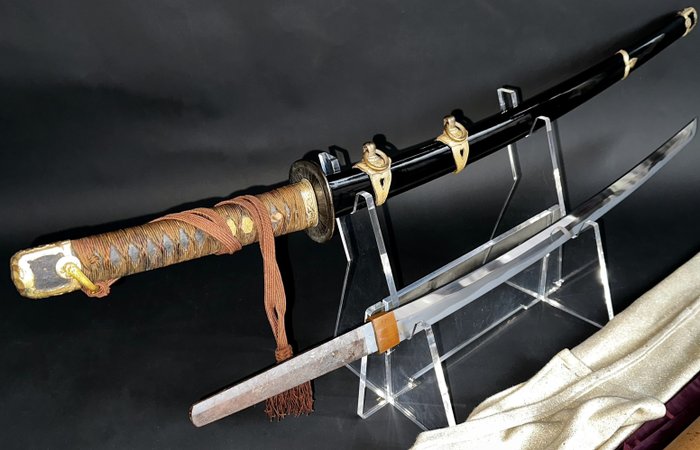
Alkuperäinen oban-puupalikkaprintti - Mulberry-paperi - Ashifune 芦舟 (fl ca 1813-18) - Kabuki actor Arashi Kichisaburo II [Arashi Rikan I] as Ono no Tofu - Japani - 1821 (Bunsei 4)
Nro. 84138497

Nro. 84138497

Minatogawa Masaaki
A beautiful original Japanese Minatogawa shrine sword by Masuda Masaaki Minatogawa Shrine Sword in Original Koshirea Masuda Masaaki inscription “Minatogawa River Shrine, Shomei, February 19, Showa 19” indicating the date of production. 1944 year February the Nagasa is 62.8 cm and a curvature of 1.6 cm. Real kikusui sword made in Minatogawa Shrine Japan. A beautiful Japanese Minatogawa sword, this type of swords has become very rare. Michimasa Murakami (name: Masatada) and Kaname Moriwaki (name: Morimitsu) from the Yasugi factory of Hitachi Metals Co., Ltd., who trained at the training association (Yasukuni Shrine), became swordsmiths at Minatogawa Shrine in Showa 15 and made military swords for naval officers. The habaki and shaft of the sword made here were carved with the Kikusui weapon and it was called the “Kikusui sword”. A design combining chrysanthemum flowers and flowing water, which was conceived because the flowing water of Ganya in Nanyang, China, is a mysterious medicine for longevity that contains chrysanthemum juice. During the Northern and Southern Dynasties, Kusunoki Masanari was given a chrysanthemum crest for Kenmu’s services, but he was so feared that he chose the chrysanthemum crest with the lower half washed away in the water as his family crest. Masanari, who committed suicide at the Battle of Minatogawa in loyalty to Emperor Go-Daigo, became a loyal vassal after his death as the “Prince of Ōkusu” when the Southern Dynasty was legitimized. This led to the creation of the Minatogawa Shrine. In the Battle of Greater East Asia, this chrysanthemum crest was painted on kamikaze planes and kamikaze ships as a sign of loyalty to the emperor and the nation. The “chrysanthemum coat of arms” was a symbol of loyalty.
Näin ostat Catawikistä
1. Löydä jotain erityistä
2. Tee korkein tarjous
3. Maksa turvallisesti